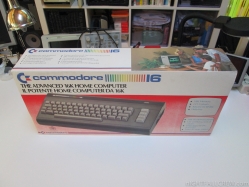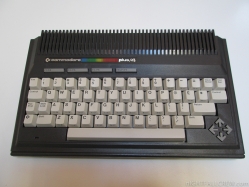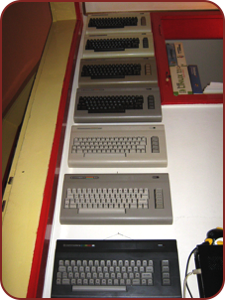Archive
Commodore 116 Keyboard Restoration and Repair
Like we know well the keyboard of the Commodore 116 may NOT be fixed because you can’t open it without break it.
The only way is break the plastic pins that hold the keyboard PCB and find the right way to close the whole thing, i leave you the right way for do this.
Once you have open it, we realize that this keyboard is a colossal shit, the conductive material of the keys is ridiculous a thin layer that is consumed very briefly.
The only way before you throw it is use the “Kontakt Chemie Graphit 33” but without spraying directly on the tiny conductive part of the key but first try on a plastic surface and then with a very fine brush take the graphite to paint the conductive part of the key.
The “Kontakt Chemie Graphit 33” with the days/months or years tends to dry, this solution make a new life to the keyboard, but not for always.
Another classic failure and is the FPC Connector (18 pins) for the keyboard flat that can be easily replaced if you find an FPC connector with 18 pins ;-D
Commodore 16 Boxed Mint Condition

Autopsy:
from Wikipedia:
The Commodore 16 was a home computer made by Commodore with a 6502-compatible 8501 CPU, released in 1984. It was intended to be an entry-level computer to replace the VIC-20 and it often sold for 99 USD. A cost-reduced version, the Commodore 116, was sold only in Europe.
The C16 was intended to compete with other sub-$100 computers from Timex Corporation, Mattel, and Texas Instruments (TI). Timex’s and Mattel’s computers were less expensive than the VIC-20, and although the VIC-20 offered better expandability, a full-travel keyboard, and in some cases more memory, the C16 offered a chance to improve upon those advantages. The TI-99/4A was priced in-between Commodore’s VIC-20 and Commodore 64, and was somewhat between them in capability, but TI was lowering its prices. On paper, the C16 was a closer match for the TI-99/4A than the aging VIC-20.
Commodore president Jack Tramiel feared that one or more Japanese companies would introduce a consumer-oriented computer and undercut everyone’s prices. Although the Japanese would soon dominate the U.S. video game console market, their feared dominance of the home computer field never materialized. Additionally, Timex, Mattel, and TI departed the computer market before the C16 was released.
Outwardly the C16 resembled the VIC-20 and the C64, but with a dark gray case and light gray keys. The keyboard layout differed slightly from the earlier models, adding an escape key and four cursor keys replacing the shifted-key arrangement inherited from the C-64 and VIC. Performance-wise located between the VIC-20 and 64, it had 16 kilobytes of RAM with 12 KB available to its built-in BASIC interpreter, and a new sound and video chipset offering a palette of 128 colors (in reality 121, since the system offered 16 base colors with 8 shades per color, but black always remained black, with all 8 shades), the TED (better than the VIC used in the VIC-20, but lacking the sprite capability of the VIC-II and advanced sound capabilities of the SID, both used in the C64). The ROM resident BASIC 3.5, however, was more powerful than the VIC-20′s and C64′s BASIC 2.0, in that it had commands for sound and bitmapped graphics (320×200 pixels), as well as simple program tracing/debugging.
source: wikipedia
Commodore Plus/4 Boxed

Autopsy:
This is a old article that i forgot to publish.
from Wikipedia:
The Commodore Plus/4 is a home computer released by Commodore International in 1984. The “Plus/4″ name refers to the four-application ROM resident office suite (word processor, spreadsheet, database, and graphing); it was billed as “the productivity computer with software built-in”. It had some success in Europe, though it was a total flop in the United States, where it was derided as the “Minus/60″—a pun on the numerical difference between the Plus/4 and the dominant Commodore 64.
In the early 1980s, Commodore found itself engaged in a price war in the home computer market. Companies like Texas Instruments and Timex Corporation were releasing computers that undercut the price of Commodore’s PET line. Commodore’s MOS Technology division had designed a video chip but could not find any third-party buyers. The VIC-20 resulted from the confluence of these events and it was introduced in 1980 at a list price of $299.95.
Later, spurred by the competition, Commodore was able to reduce the VIC’s street price to $99, and it became the first computer to sell over 1 million units. The Commodore 64, the first 64-kB computer to sell for under 600 US$, was another salvo in the price war but it was far more expensive to make than the VIC-20 because it used discrete chips for video, sound, and I/O. Still, the C-64 went on to become a best-seller and was selling for $199 at the time of the Plus/4′s introduction.
Even while C64 sales were rising, Commodore president Jack Tramiel wanted a new computer line that would use fewer chips and at the same time address some of the user complaints about the VIC and C64.
source: wikipedia
Commodore C16/C116 for Spare Parts
Commodore C16/C116 for Spare Parts donated by Damiano Colombari (Manosoft). Thanks Damiano.
Art of Commodore 100% Final
Description:
- Commodore VIC-20 Generation Two
- Commodore VIC-20 Generation One (Pet Function key style)
- Commodore VC-20 (Pet Function key style)
- Commodore 64 Generation One (Pet Function key style)
- Commodore 64 Generation Two (The classic one)
- Commodore 64 G
- Commodore 64 Aldi
- Commodore 16
All Commodore’s are in perfect state and working like new.
Art of Commodore Part2 *updated*
Commodore 116 (264 series)
Autopsy:
I have also a tape drive Datasette (black), tape drive adapter, manual, and joystick adapter.
Description:
- Country: USA
- Most Common: Europe
- Rarity: Rare
- Year: 1984
The low end members of the 264 series are the Commodore 16 and the Commodore 116. Of all the machines showcased at the C.E.S., the C116 was the only model to make it to store shelves as originally designed; though it was only in Europe, and in very small numbers.
The Commodore 116 was originally slated to be the only machine in this series, and was designed by engineers at Commodore-US.
source: Zimmers.net
Art of Commodore *updated*


I have hung some commodore on the wall like paintings, i have others to hang…but my room is very small.
Description from top:
- Commodore VIC-20 Generation One (Pet Function key style)
- Commodore VIC-20 Generation Two
- Commodore 64 Generation One (Pet Function key style)
- Commodore 64 Generation Two (The classic one)
- Commodore 64 G
- Commodore 64 Aldi
- Commodore 16
Vintage Computer Collection. *Updated*
This is a small part of my vintage computer collections.
A Description of the photo’s:
Photo #1: 1541 Jiffy, 1541 II Jiffy, 1581 Jiffy, C64 with a First generation motherboard + MultiKernel (Atmel Flash), Nes Pal/Ntsc, a Lame Windows PC, Debian Laptop.
Photo #2: Commodore 1084S, C64, some Original box of Commodore.
Photo #3: 1541 Original Box, Commodore Dtv PAL, Plus4, C16, C64, Spectrum Joystick Interface,Zx81, Spectrum, Vic20, C64G, C64 II, C16 Cartridges and on the wall a C64 Motherboard ;-DD
Photo #4: Zoom of C128 and C64 II logo.
Photo #5: C128 and a first version of C64 II (new case but with old Motherboard / Keyboard)
Photo #6: Amiga 600 + 1MB + CompactFlash HD.
Photo #7: Commodore 1084S, Amiga 3000 (old memories)







































































Recent Comments